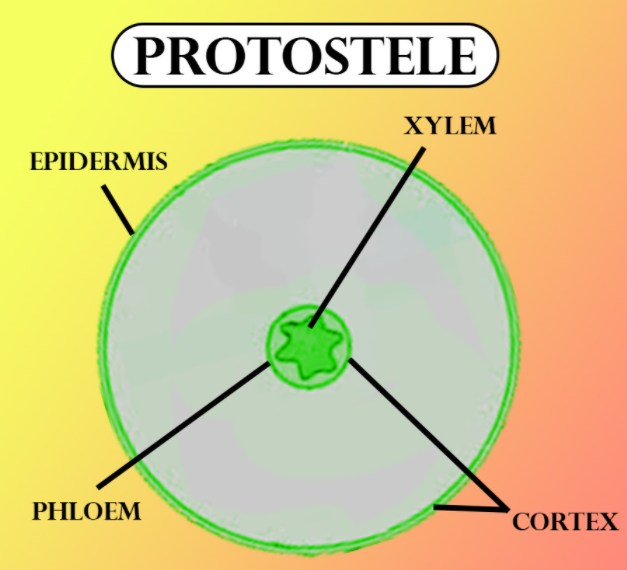
Protosteles are found in
(a)Bryophyta
(b)Gymnosperms
(c)Pteridophyta
(d)Angiosperms
Answer
576.6k+ views
Hint: Protosteles are commonly found in Equisetum and Dryopteris. They are regarded as the first plants to be evolved on earth. Protosteles exist in vascular plants. This community is seedless, vascular, and cryptogam.
Complete answer:
Protosteles are the most complex type of stellar organization among all pteridophytes. They are solid steel with most origins, having a phloem-enclosed central xylem core. In their rhizome, stem or roots, most of the pteridophytes exhibit protostelic character.
Additional Information: The gymnosperm and dicotyledonous stem are distinguished by Eustele. Eustele can be characterized as an ectophloic siphonostele type with overlapping gaps in the leaves. Polysteles occur in angiosperms in families such as the Acanthaceae, Nymphaeaceae, Palmae, etc. Polystele can be described as having more than one protostele, as seen in a stem's cross-section.
Pteridophytes exhibit alternating generations. Their life cycle is similar to seed-bearing plants, but as both haploid gametophyte and diploid sporophyte generations are separate and free-living, the pteridophytes vary from mosses and seed plants.
Unlike most other Plant Kingdom members, pteridophytes do not reproduce by seeds, instead, they reproduce through spores.
There are four kinds of protostele. They are haplostele, actinostele, plectostele, and mixed protostele.
So, the correct answer is, ‘Pteridophyta’.
Note: The stele is the central part of the root or stem in a vascular plant. They contain the tissues derived from the procambium. These include vascular tissue, ground tissue (pith) in certain cases, and a pericycle that determines the stele's outermost boundary if present. The endodermis sits outside the stele, which is the cortex's innermost cell layer.

Complete answer:
Protosteles are the most complex type of stellar organization among all pteridophytes. They are solid steel with most origins, having a phloem-enclosed central xylem core. In their rhizome, stem or roots, most of the pteridophytes exhibit protostelic character.
Additional Information: The gymnosperm and dicotyledonous stem are distinguished by Eustele. Eustele can be characterized as an ectophloic siphonostele type with overlapping gaps in the leaves. Polysteles occur in angiosperms in families such as the Acanthaceae, Nymphaeaceae, Palmae, etc. Polystele can be described as having more than one protostele, as seen in a stem's cross-section.
Pteridophytes exhibit alternating generations. Their life cycle is similar to seed-bearing plants, but as both haploid gametophyte and diploid sporophyte generations are separate and free-living, the pteridophytes vary from mosses and seed plants.
Unlike most other Plant Kingdom members, pteridophytes do not reproduce by seeds, instead, they reproduce through spores.
There are four kinds of protostele. They are haplostele, actinostele, plectostele, and mixed protostele.
So, the correct answer is, ‘Pteridophyta’.
Note: The stele is the central part of the root or stem in a vascular plant. They contain the tissues derived from the procambium. These include vascular tissue, ground tissue (pith) in certain cases, and a pericycle that determines the stele's outermost boundary if present. The endodermis sits outside the stele, which is the cortex's innermost cell layer.

Recently Updated Pages
Why are manures considered better than fertilizers class 11 biology CBSE

Find the coordinates of the midpoint of the line segment class 11 maths CBSE

Distinguish between static friction limiting friction class 11 physics CBSE

The Chairman of the constituent Assembly was A Jawaharlal class 11 social science CBSE

The first National Commission on Labour NCL submitted class 11 social science CBSE

Number of all subshell of n + l 7 is A 4 B 5 C 6 D class 11 chemistry CBSE

Trending doubts
Differentiate between an exothermic and an endothermic class 11 chemistry CBSE

10 examples of friction in our daily life

One Metric ton is equal to kg A 10000 B 1000 C 100 class 11 physics CBSE

Difference Between Prokaryotic Cells and Eukaryotic Cells

State the laws of reflection of light

Explain zero factorial class 11 maths CBSE




